Filterable Picrew Database!
filterable picrew database!
hey pals!! i'm working on a filterable, tagged collection of picrew i like. right now there's about 60 picrew (and other such makers such as those from neka or meiker) in there with tags for things like fashion, hair options, skin colors, specific features like horns or headscarves, and body types. you can search for multiple tags at a time and filter out tags you don't want. the whole thing is organized in a big grid of sample results from the picrew in question, so you can see the style at a glance and click it for more images and the url, but you can change the view and organization system however you like.




the link is here!!! feel free to share this wherever. i'm still going through my folders and adding more makers, so expect lots of updates real soon.
i'm hoping this makes it easier for people to find picrew that suit them and their characters, especially in cases where it's unfortunately harder to find certain features like dark skin options and fat bodies.
have fun!!!! i hope this is helpful for people!!!
More Posts from Madadreferencearchive and Others
You know, I bet the Ferengi have someone like Ea-Nasir and he's like. a saint or something
Los Angeles Times! See me, more patients and the studio!
So you may have wondered why Habersham's story followed so quickly on the heels of Lucky the Bear's, and the reason is, it was a bit of a teaser.
Over the past few months, I have been interviewed for almost 2 hours by a reporter for the LA Times. Then a photographer came out to the hospital and took photos of me and the hospital and the patients I had at the time (for another two hours!). And then a few weeks ago, another photographer came out to take portraits of the patients I had then. Including one of Habersham. Then, yesterday, September 10, this appeared as the cover of the LA Times Calendar section:

That's Habersham before his surgery. And a wonderful play on Tears for Fears for the title of the story. :-) There's a two page spread inside the paper, and you can read it, and see a lot (if not all) of the photos online here. If the link doesn't work, you can also go to the LA Times and search "toy hospital" in the search box on the site and you should find the article that way too.
Anyway, as you may imagine, I've been doing a bit of a happy dance about the story all weekend. And I really wanted to share it with all of you because a) I thought you might enjoy the article and b) the reporter found me in part because of this blog which you all have chosen to read and follow and like over the years, so you all deserve thanks for the article too!
beth
spotify users: what is the current title of your daylist and what are the first three songs?
i am not joking we need to force teach cooking in schools. like. it is an essential thing for survival. do you know how easy it is to make things if you know even the bare bones shit about how cooking works. we need to teach teenagers how far you can take an onion and some other veggies it''s sad that people grow up not knowing how to prepare literally anything. and i'm not talking about oh this home ed class taught me how to make chicken nuggets at home i'm talking about learning the balancing of sweetness and acidity and saltiness and bitterness and shit like that and techniques and oil temperatures and how meats cook. it needs to be taught because it's literally not even that difficult and it matters so much
USERNAME LORE GIVE IT TO ME NOW YOU ALL
Visible Mending
Introduction:
Visible mending is a decorative way to fix up an item. Instead of trying to make your mend as invisible as possible, the idea is to make it part of the garment's design.
Visual mending is not a single technique: it's more of a mindset. If you've got an item you love, it deserves to be mended, and if you're going to put that love into stitches, why not show them off?
That being said, there are some specific techniques that are popular with visible menders. Let's take a look!
Sashiko:
Sashiko is a type of traditional Japanese embroidery that is used to both decorate and reinforce fabric. In visible mending, sashiko is often used to cover up holes with patches or to reinforce thinning fabric. This technique uses a variation on the running stitch.
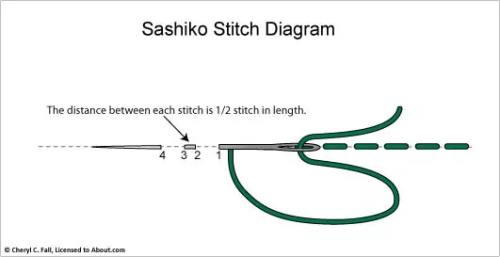
(Image source) [ID: sashiko stitch diagram: the distance between each stitch is 1/2 stitch in length.]
Some resources on sashiko:
SashiCo on YouTube: sashiko livestreams and information on the cultural aspect of sashiko.
Written tutorial by Upcycle Stitches.
Free sashiko templates by TheSpruceCrafts.
Fixing jeans with sashiko by Soluna Collective.
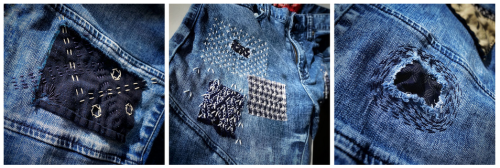
(Image source) [ID: three examples of sashiko embroidery on jeans fabric.]
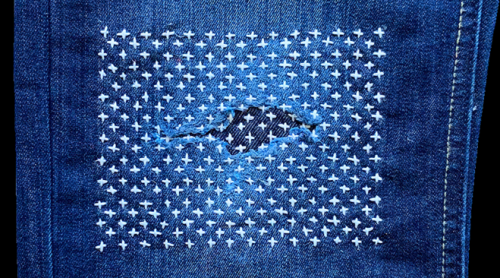
(Image source) [ID: sashiko embroidery with white thread on blue jeans fabric.]
Embroidery:
Regular embroidery is also a popular technique to accentuate your mends. Check out my embroidery 101 post to learn how to get started. You can embroider patches, or use embroidery to hide or accentuate any stitches you've made to fix holes. Embroidery's also a great way to cover up stains.
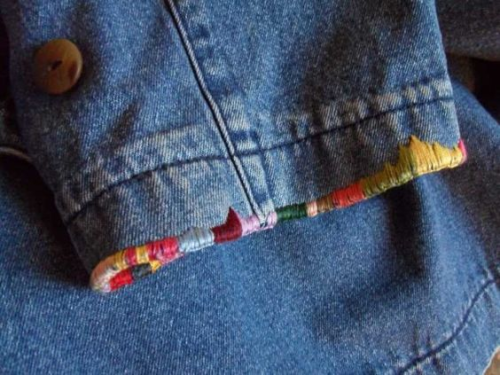
(Image source) [ID: colourful embroidery floss covers a worn sleeve edge of a jeans jacket]
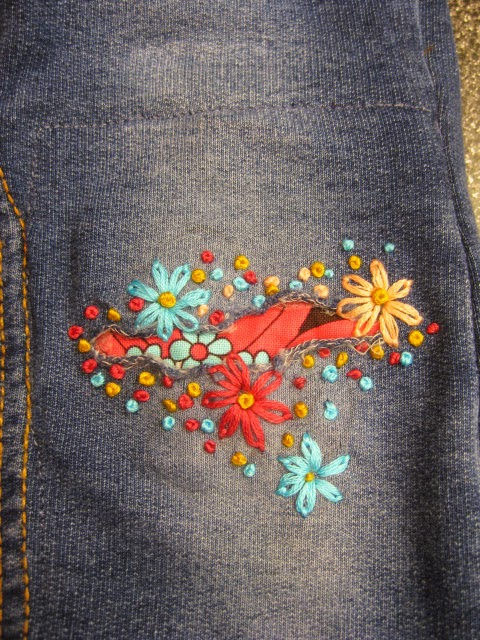
(Image source) [ID: colourful flower embroidery surrounds a hole in a pair of dark gray jeans. Fabric with a red and black flower print peaks out of the hole.]
Patches:
There are many ways to add patches to a garment. My tutorial on patches is a good place to start if you want to make custom-shaped patches to sew on top of your fabric. You can also sew your patch on the inside of your garment and have it peek out from beneath the hole you're trying to fix. Fun ideas for this are lace or superheroes.
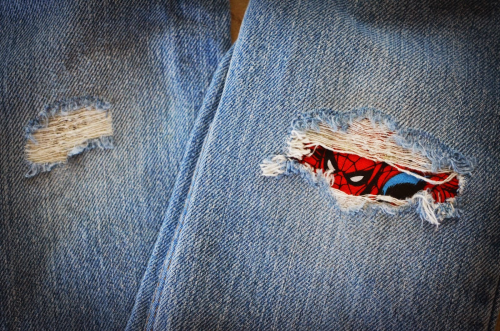
(Image source) [ID: Spiderman peaking out of a rip in a pair of blue jeans.]

(Source) [ID: a red flannel heart-shaped elbow patch on a gray knitted sweater.]
Darning:
Darning is a technique used to repair holes in fabric by using running stitches to weave extra fabric over the hole as to fill it up again. While traditionally darning is done in an invisible way by using the same colour of thread as your fabric, you can also use contrasting colours to accentuate your fix. Check out this written tutorial on darning by TheSpruceCrafts.
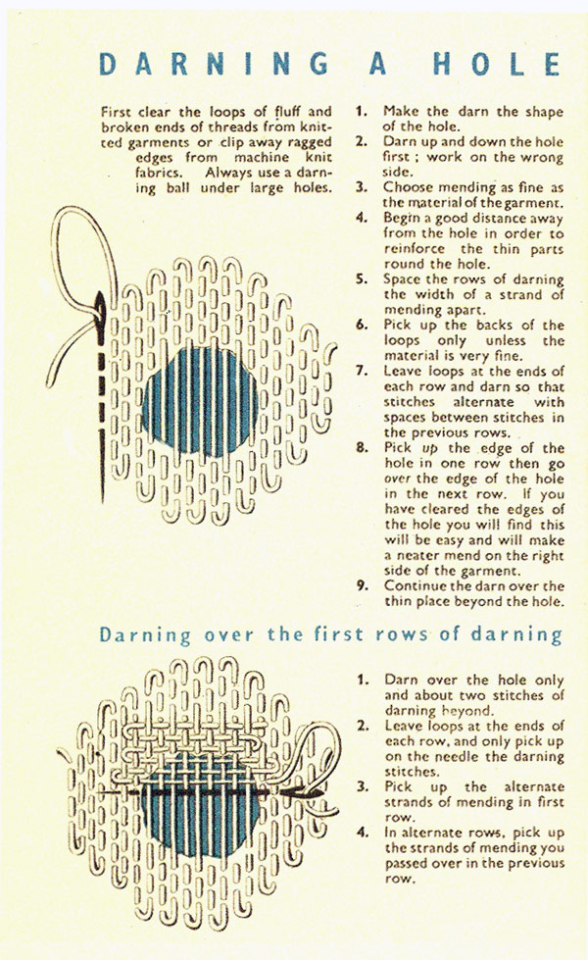
(Image source) [ID: vintage instructions on how to darn a hole.]
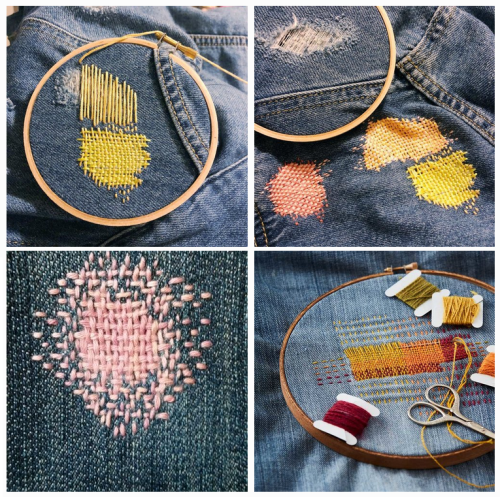
(Image source) [ID: four examples of darning on blue fabric with colourful contrasting thread.]
Conclusion:
Visible mending is a creative way to fix up your clothes and give them some personality at the same time.
You should be proud of the fact that you took the time and learned the necessary skills needed to mend your clothes! Show off what you did!
A fun side effect of wearing these obvious mends is that people will notice them. They'll remember your fixes the next time they're faced with a hole in their wardrobe, and it will make them more likely to try it for themselves.
These are just a few ways to visibly mend your garments. Want more inspiration? Check out Pinterest or r/Visiblemending on Reddit.
Oh? You're unlovable and God will never forgive you? Wrong. DIVINE MERCY ATTACK ❤️🤍💙❤️🤍💙❤️🤍💙❤️🤍💙❤️🤍💙❤️🤍💙❤️🤍💙❤️🤍💙❤️🤍💙❤️🤍💙❤️🤍💙❤️🤍💙❤️🤍💙❤️🤍💙❤️🤍💙❤️🤍💙❤️🤍💙❤️🤍💙❤️🤍💙❤️🤍💙❤️🤍💙❤️🤍💙❤️🤍💙❤️🤍💙❤️🤍💙❤️🤍💙❤️🤍💙❤️🤍💙❤️🤍💙❤️🤍💙❤️🤍💙❤️🤍💙❤️🤍💙
RESOURCES FOR POSES
Line of Action

JustSketch.Me

PoseManiacs

Human-Anatomy-For-Artist.com

MagicPoser

MIXAMO

Pose Archives

Bodies in Motion

Posemy.art

ReferenceAngle

CroquisCafe


>100,000 notes - mass market slop
10,000 notes - well executed crowd pleaser
1,000 notes - cult classic
100 notes - uncompromising avant-garde art for those of discerning taste
10 notes - misunderstood genius that the culture is not yet ready for
1 note - direct admission of suicidal ideation
-
 vampmaidenslair liked this · 4 days ago
vampmaidenslair liked this · 4 days ago -
 ghostwithskull liked this · 5 days ago
ghostwithskull liked this · 5 days ago -
 soft-girl-writing-resources reblogged this · 1 week ago
soft-girl-writing-resources reblogged this · 1 week ago -
 notunlikepride liked this · 1 week ago
notunlikepride liked this · 1 week ago -
 theshakespearetrash liked this · 1 week ago
theshakespearetrash liked this · 1 week ago -
 borom1r reblogged this · 1 week ago
borom1r reblogged this · 1 week ago -
 cockroachcoffee reblogged this · 1 week ago
cockroachcoffee reblogged this · 1 week ago -
 pjfree0216 liked this · 1 week ago
pjfree0216 liked this · 1 week ago -
 havblaa liked this · 2 weeks ago
havblaa liked this · 2 weeks ago -
 why-do-i-do-this liked this · 2 weeks ago
why-do-i-do-this liked this · 2 weeks ago -
 mr-bop-reblogs reblogged this · 2 weeks ago
mr-bop-reblogs reblogged this · 2 weeks ago -
 caeb-ruu liked this · 2 weeks ago
caeb-ruu liked this · 2 weeks ago -
 dayundying liked this · 2 weeks ago
dayundying liked this · 2 weeks ago -
 neznakomkka liked this · 2 weeks ago
neznakomkka liked this · 2 weeks ago -
 c0smicsalt liked this · 3 weeks ago
c0smicsalt liked this · 3 weeks ago -
 crystheoneandonly reblogged this · 3 weeks ago
crystheoneandonly reblogged this · 3 weeks ago -
 crystheoneandonly liked this · 3 weeks ago
crystheoneandonly liked this · 3 weeks ago -
 pdfbabe liked this · 3 weeks ago
pdfbabe liked this · 3 weeks ago -
 kis-kis-the-fis-fis reblogged this · 3 weeks ago
kis-kis-the-fis-fis reblogged this · 3 weeks ago -
 saiiboat reblogged this · 3 weeks ago
saiiboat reblogged this · 3 weeks ago -
 only-the-important-stuff reblogged this · 3 weeks ago
only-the-important-stuff reblogged this · 3 weeks ago -
 fandomresourcesandother reblogged this · 3 weeks ago
fandomresourcesandother reblogged this · 3 weeks ago -
 idiot-baby-apple-fight liked this · 3 weeks ago
idiot-baby-apple-fight liked this · 3 weeks ago -
 orchestralauthor reblogged this · 4 weeks ago
orchestralauthor reblogged this · 4 weeks ago -
 molqr liked this · 4 weeks ago
molqr liked this · 4 weeks ago -
 greenieflor reblogged this · 1 month ago
greenieflor reblogged this · 1 month ago -
 kirkwallsbane liked this · 1 month ago
kirkwallsbane liked this · 1 month ago -
 magicalgirlvioletstarshine liked this · 1 month ago
magicalgirlvioletstarshine liked this · 1 month ago -
 hyakinthou-naos liked this · 1 month ago
hyakinthou-naos liked this · 1 month ago -
 lemoshima liked this · 1 month ago
lemoshima liked this · 1 month ago -
 gardenkeeper reblogged this · 1 month ago
gardenkeeper reblogged this · 1 month ago -
 gardenkeeper liked this · 1 month ago
gardenkeeper liked this · 1 month ago -
 pawprintedpages liked this · 1 month ago
pawprintedpages liked this · 1 month ago -
 cosmogyros liked this · 1 month ago
cosmogyros liked this · 1 month ago -
 derflauschigstefuchs reblogged this · 1 month ago
derflauschigstefuchs reblogged this · 1 month ago -
 justapineapplesworld liked this · 1 month ago
justapineapplesworld liked this · 1 month ago -
 waywardkingdomdreamer liked this · 1 month ago
waywardkingdomdreamer liked this · 1 month ago -
 dreadmagnificence reblogged this · 1 month ago
dreadmagnificence reblogged this · 1 month ago -
 orchestralauthor liked this · 1 month ago
orchestralauthor liked this · 1 month ago -
 bugfromheaven liked this · 1 month ago
bugfromheaven liked this · 1 month ago -
 sweetnekoheart liked this · 1 month ago
sweetnekoheart liked this · 1 month ago -
 ahsokatanoisbi liked this · 1 month ago
ahsokatanoisbi liked this · 1 month ago -
 walkingweirdmageddon reblogged this · 1 month ago
walkingweirdmageddon reblogged this · 1 month ago -
 charlienichol liked this · 1 month ago
charlienichol liked this · 1 month ago -
 mistykitten-gxm liked this · 1 month ago
mistykitten-gxm liked this · 1 month ago -
 marzzrocks liked this · 1 month ago
marzzrocks liked this · 1 month ago -
 lowkey-mynx liked this · 1 month ago
lowkey-mynx liked this · 1 month ago -
 needingsleep reblogged this · 1 month ago
needingsleep reblogged this · 1 month ago -
 sainamoonshine liked this · 2 months ago
sainamoonshine liked this · 2 months ago

Hey my main is mad-ad I use this side blog to keep posts I want to save handy and my drafts clear
76 posts